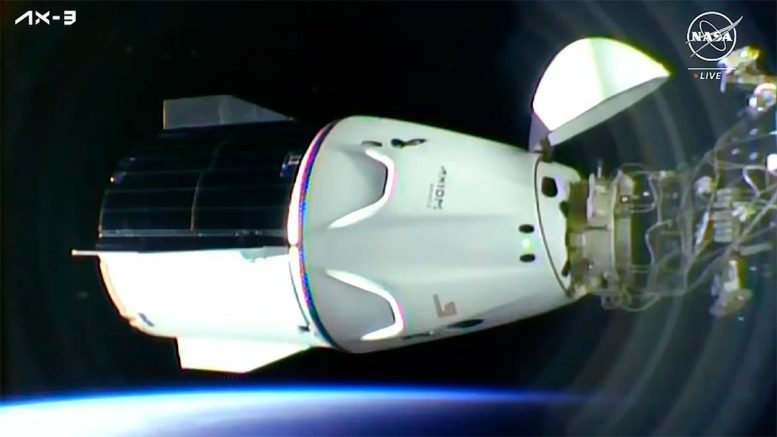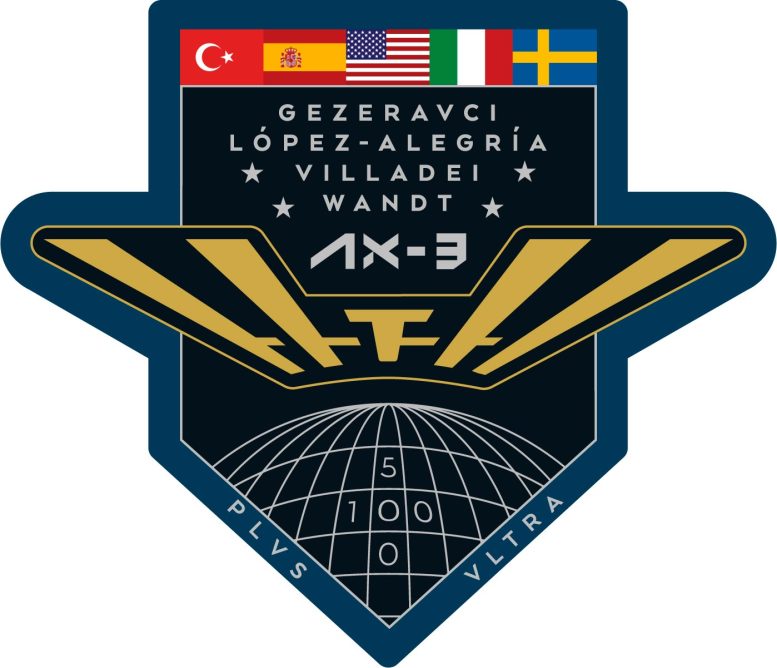

The SpaceX Dragon Freedom spacecraft carrying four Axiom MIssion 3 astronauts is pictured docked to the space station shortly after an orbital sunrise. Credit: NASA TV
Unfavorable weather conditions have led NASA and its partners to postpone the February 6 undocking of Axiom Mission 3.
NASA, Axiom Space, and SpaceX are standing down from the Tuesday, February 6, undocking opportunity of Axiom Mission 3 from the International Space Station due to unfavorable weather conditions in the splashdown zone. Ax-3 was originally scheduled to return to Earth on February 3, but that was also delayed due to adverse weather conditions.
Mission teams will continue to review weather conditions off the coast of Florida, which currently are not favorable for return, and set a new target opportunity for space station departure and splashdown of the Dragon spacecraft and Axiom crew members.
The next weather review is planned for 12 p.m., February 6. NASA will provide additional information on the next undocking opportunity as available.
Aboard the International Space Station, Axiom Mission-3 crewmembers Michael López-Alegría, Walter Villadei, Alper Gezeravcı, and Marcus Wandt provided farewell remarks on February 2 ahead of their scheduled undocking from the space station on February 3 (which was subsequently delayed to February 5 and now delayed again). The crew has been living and working on the International Space Station since January 20 following a launch from the Kennedy Space Center in Florida on January 18. Axiom Mission-3 is the third private astronaut mission to the space station. Credit: NASA


The Axiom Mission 3 (Ax-3) patch is shaped as a shield to illustrate strength and courage. The International Space Station (ISS) is centered and angled to be seen as aviator wings, symbolizing four astronauts piloting toward growth in low-Earth orbit (LEO) through the spirit of exploration and collaboration. Credit: Axiom Space
Axiom Mission 3 (Ax-3), marking a significant milestone in commercial spaceflight, is the first all-European commercial astronaut mission to the International Space Station (ISS). The mission was launched successfully aboard a SpaceX Falcon 9 rocket from NASA’s Kennedy Space Center in Florida on January 18, with the Dragon spacecraft docking with the ISS Harmony module on January 20.
Commanded by Michael López-Alegría, with Pilot Walter Villadei, and Mission Specialists Alper Gezeravcı and Marcus Wandt, the crew represents a collaborative effort between the United States, Spain, Italy, Türkiye, Sweden, and the European Space Agency (ESA).
Originally scheduled for a 14-day mission duration, the Ax-3 crew was tasked with conducting over 30 experiments and engaging in more than 50 outreach activities. These scientific endeavors aim to enhance our understanding of human physiology in microgravity and on Earth, while also exploring opportunities for industrial and technological advancements in space.
Ax-3 not only highlights the collaboration between government and commercial entities in advancing human spaceflight but also features notable firsts. Mission Specialist Alper Gezeravcı becomes the first Turkish astronaut to participate in a space mission, and Marcus Wandt is recognized as the first ESA astronaut to fly on a commercial space mission. This venture is a precursor to the ambitious Axiom Station, envisioned as the world’s first commercial space station, and exemplifies the expanding horizons of international space exploration and commercialization.
